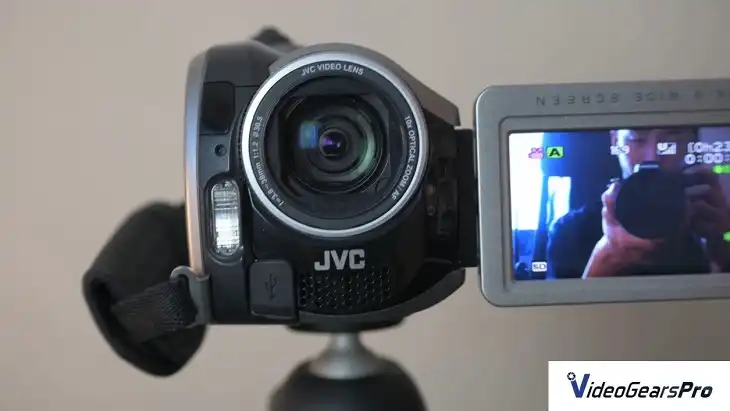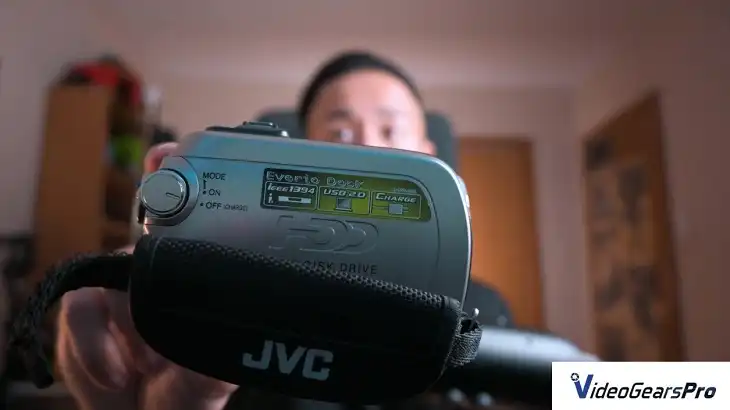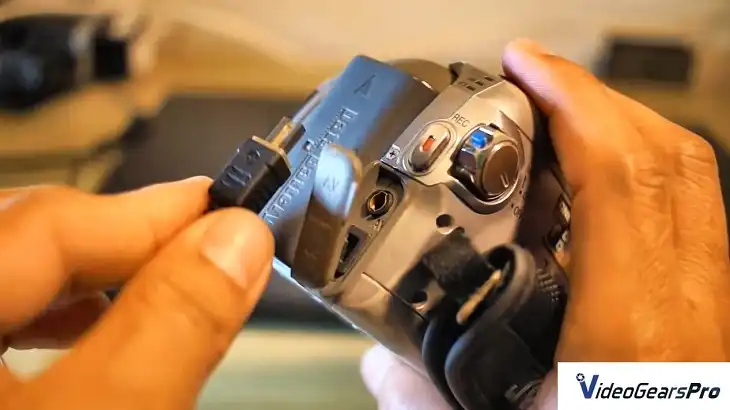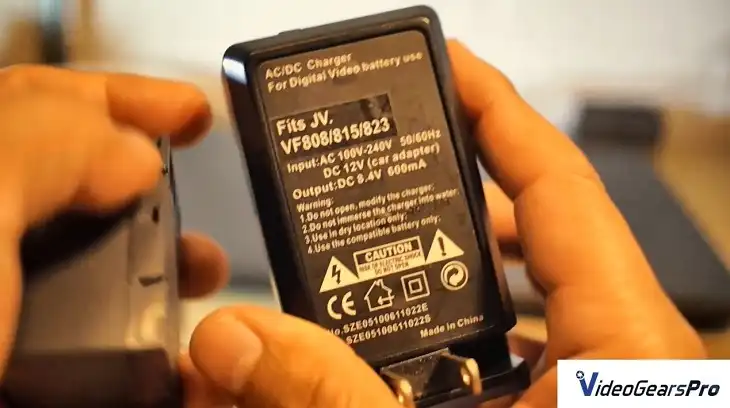Lost your JVC Everio camcorder charger? Don’t panic! You’re not alone, and there are several ways to power up your device without the original charger.
Whether you’re in the middle of a crucial project or just want to relive some cherished memories, we’ve got you covered with some clever workarounds.
In this guide, we’ll walk you through various methods to charge your JVC Everio camcorder when you’re in a pinch.
From using a standard USB cable to exploring universal charger options, we’ll cover all the bases to get your camera juiced up and ready to roll. Remember, while these methods can save the day, they’re not all created equal.
We’ll discuss the pros and cons of each approach, helping you choose the best option for your situation. Plus, we’ll throw in some tips on how to keep your battery healthy in the long run.

Understanding Your JVC Everio Camcorder

Before we dive into charging methods, let’s make sure we’re on the same page about your camcorder. This step is crucial because different models might have slightly different charging needs.
Identifying Your Model
- Look for the model number: It’s usually printed on the bottom or side of your camcorder. It might start with “GZ-” followed by letters and numbers.
- Check your user manual: If you still have it, the manual will have your exact model info.
- Use the JVC website: They have a product finder that can help you identify your model based on its features.
Pro tip: Jot down your model number somewhere safe. It’ll come in handy if you need to find replacement parts or ask for help online.
Locating The Charging Port
JVC Everio camcorders typically have their charging ports in one of these spots:
- Behind a small flap on the side or back of the camera
- Under the battery compartment
- Near the hand strap
The port might be labeled “DC IN” or have a battery icon next to it. If you’re not sure, consult your user manual or look up an image of your model online.
Remember: Don’t force anything! If a cable doesn’t fit easily, double-check that you’ve got the right port.
Charging JVC Everio Camcorder Using a USB Cable

Good news! Many JVC Everio models can be charged using a standard USB cable. This method is often the most convenient when you’re in a pinch.
Required Equipment
- A USB cable (usually Mini-USB or Micro-USB)
- A USB power source (computer, wall adapter, power bank, etc.)
Step-By-Step Charging Process
- Locate your camcorder’s USB port (often behind a small flap).
- Connect the USB cable to your camcorder.
- Plug the other end into your power source.
- Your camcorder should indicate it’s charging (check the screen or for a charging light).
- Let it charge fully before unplugging.
Pros Of This Method
- Convenience: USB cables and power sources are widely available.
- Versatility: You can charge from various sources (computer, wall outlet, car, etc.).
- Cost-effective: No need to buy a special charger.
Cons Of This Method
- Slower charging: USB charging is often slower than using the original charger.
- Potential compatibility issues: Not all models support USB charging.
- Risk of using incorrect voltage: Make sure your power source matches your camcorder’s needs.
Pro tip: If your computer doesn’t recognize the camcorder when plugged in, try a different USB port or cable. Sometimes it’s just a finicky connection!
Remember, while USB charging can be a lifesaver, it’s not always the fastest or most efficient method. If you use your camcorder frequently, consider investing in a replacement for your original charger for the best long-term solution.
Charging Using A Universal Charger

When you can’t find a USB charging option, a universal charger can be your next best bet. These handy devices can charge a variety of batteries, including those used in JVC Everio camcorders.
Selecting A Compatible Universal Charger:
- Check your battery type: Most JVC Everio camcorders use lithium-ion batteries.
- Look for voltage compatibility: Ensure the charger can output the correct voltage for your battery (usually 7.2V or 3.6V for JVC models).
- Consider adjustable voltage: Some universal chargers let you adjust the voltage, which is great for future-proofing.
- Read reviews: Look for chargers with good reviews from camcorder users.
Safety Precautions
- Verify compatibility: Double-check that your battery fits the charger contacts snugly.
- Use the correct voltage setting: Using too high a voltage can damage your battery.
- Avoid cheap knock-offs: Stick to reputable brands to reduce the risk of battery damage or fire.
- Never leave charging unattended: Always keep an eye on the charging process.
Charging Instructions
- Remove the battery from your camcorder.
- Set the charger to the correct voltage for your battery.
- Place the battery in the charger, ensuring proper contact.
- Plug the charger into a power outlet.
- Wait for the charging indicator light to show it’s complete (usually turns green).
- Remove the battery and reinsert it into your camcorder.
Pro tip: Some universal chargers come with car adapters, which can be super handy for on-the-go charging!
Battery-Only Charging Options
Sometimes, you might want to charge your battery separately from your camcorder. This can be useful if you have multiple batteries or want to use your camcorder while charging a spare.
External Battery Chargers:
- Dedicated JVC chargers: These are designed specifically for your battery model.
- Third-party chargers: Often more affordable but ensure they’re compatible with your battery.
- Dual-battery chargers: Great for charging two batteries at once if you’re a heavy user.
How To Use Them Safely:
- Match the charger to your battery: Ensure it’s designed for your specific battery model.
- Check for proper insertion: The battery should fit snugly without force.
- Use in a well-ventilated area: Avoid charging in extreme temperatures or humid environments.
- Unplug when not in use: Don’t leave the charger plugged in when it’s not charging.
- Inspect regularly: Look for any signs of wear or damage on both the charger and battery.
Pro tip: Consider getting a spare battery and external charger. This way, you can always have a charged battery ready to go, even on long shoots.
Remember, while these methods can get you out of a jam, it’s always best to use the original charger when possible.
If you find yourself regularly relying on alternative charging methods, it might be time to invest in a replacement original charger for the best performance and battery life.
Emergency Charging Hacks
Sometimes, you need to get creative when you’re in a pinch. Here are some emergency charging hacks that could save the day.
Using A Power Bank
- Check compatibility: Ensure your power bank can output the correct voltage.
- Use the right cable: Most power banks use USB, so you’ll need the appropriate USB to camcorder cable.
- Charge on the go: Power banks are portable, so you can charge while traveling.
- Monitor the charge: Some power banks shut off automatically, so keep an eye on it.
Car Charger Adaptations
- Use a car USB port: If your camcorder charges via USB, you can use your car’s USB port.
- Invest in a car power inverter: This device turns your car’s 12V outlet into a standard wall outlet.
- Look for camcorder-specific car chargers: Some manufacturers make car chargers for their camcorders.
Pro tip: In a real emergency, some camcorders can be powered directly from a laptop’s USB port while you’re filming. It’s not ideal, but it could save a crucial shot!
Tips for Maintaining Battery Life
Taking care of your battery can save you from charging headaches in the future.
Best practices for battery care:
- Avoid extreme temperatures: Don’t leave your camcorder or battery in very hot or cold places.
- Store at partial charge: For long-term storage, keep batteries at about 40% charge.
- Use regularly: Try to use and recharge your battery at least once a month.
- Clean contacts: Keep the battery contacts clean for better connection.
- Avoid overcharging: Remove the battery from the charger once it’s full.
Extending battery life during use:
- Lower screen brightness: A dimmer screen uses less power.
- Use the viewfinder: If your model has one, it uses less power than the LCD screen.
- Avoid extreme zoom: Zooming in and out frequently drains the battery faster.
- Turn off Wi-Fi: If your model has Wi-Fi, turn it off when not in use.
- Use power-saving mode: Many camcorders have a power-saving or ECO mode.
Conclusion
Losing your JVC Everio charger doesn’t have to mean the end of your filming adventures. With the methods we’ve discussed – from USB charging to universal chargers, and even emergency hacks – you’ve got plenty of options to keep your camcorder powered up.
Remember, while these alternative charging methods can be lifesavers, they’re not all created equal. USB charging is convenient but slower, universal chargers are versatile but require careful selection, and emergency hacks should be just that – for emergencies.
For the best performance and longest battery life, try to get a replacement for your original charger when you can. In the meantime, take good care of your battery with proper charging habits and power-saving techniques during use.
Don’t let a missing charger stop you from capturing life’s precious moments. With these tips and tricks, you’ll be ready to roll whenever inspiration strikes. Happy filming!
FAQs
1. Can I Charge My JVC Everio Camcorder Through The USB Port?
Many JVC Everio models can be charged via USB, but not all. Check your user manual or the JVC website to confirm if your model supports USB charging.
If it does, use a standard USB cable connected to a computer, wall adapter, or power bank. Note that USB charging is usually slower than using the original charger, so allow extra time.
2. Is It Safe To Use A Universal Charger For My JVC Everio Battery?
Using a universal charger can be safe if precautions are taken. Ensure compatibility with your battery type and correct voltage (typically 7.2V or 3.6V for JVC). Use a reputable brand, set the correct voltage, and monitor the process.
Universal chargers may lack the protection of the original, so use them cautiously and do not leave charging unattended.
3. How Can I Charge My JVC Everio Battery If I’m On A Road Trip?
For road trips, use your car’s USB port or a car charger if your camcorder supports USB charging. Alternatively, a car power inverter can convert DC to AC for your original or universal charger. Car-specific chargers for camcorder batteries are also available and convenient for travelers.
4. Will Using Alternative Charging Methods Damage My JVC Everio Battery?
Alternative charging methods shouldn’t damage your battery if used correctly. Risks arise from incorrect voltage or poor-quality chargers. USB charging from reliable sources is generally safe, but avoid cheap third-party chargers. Investing in a high-quality universal or replacement original charger minimizes risks.
5. Can I Use A Power Bank To Charge My JVC Everio Camcorder?
Yes, if your model supports USB charging, you can use a power bank. Ensure the power bank outputs the correct voltage (usually 5V) and use the appropriate cable. This is useful when no wall outlet is available, though charging may be slower than with a wall charger.
6. How Long Does It Take To Charge A JVC Everio Battery Using Alternative Methods?
Charging times vary by method and battery model. USB charging is typically slower, taking 4-6 hours. Universal chargers charge similarly to the original, around 2-4 hours. Power banks and car chargers vary widely. Time a full charge from a depleted battery to get an accurate estimate for your method.
7. My JVC Everio Won’t Turn On Even After Charging With An Alternative Method. What Should I Do?
If your JVC Everio won’t turn on, ensure the battery is properly inserted and contacts are clean. Remove and reinsert the battery, or test with a known good battery or original charger. Check for a reset button and try resetting. If the issue persists, contact JVC support or a repair service.
